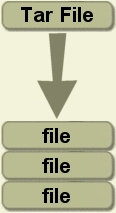1.4.2 Tar Distributions: Installation and Compilation

Our tar files are created using the GNU version of tar,
often called gtar.
On some systems this will be installed as tar, on others it will be
installed as gtar. To check whether you have the right version,
type "tar --version". The resulting message displayed to the screen
should include the statement
"Copyright (C) ... Free Software Foundation, Inc.".
To make sure that you have correctly transfered the tar file,
you can list its contents using the following command
(assuming the file was downloaded using the name isip.tar.gz):
The option "f" identifies the tar file name. The option "z" indicates
the tar file is a compressed tar file and must be decompressed
(".gz" is the filename extension we use for such a file).
The result of this command will be a display that looks like this:
isip006_[2]: tar tzf ./isip.tar.gz | more
isip_r00_n09/
isip_r00_n09/doc/
isip_r00_n09/doc/examples/
isip_r00_n09/doc/examples/GNUmakefile
isip_r00_n09/doc/examples/class/
isip_r00_n09/doc/examples/class/asr/
isip_r00_n09/doc/examples/class/asr/asr_example_00/
...
isip_r00_n09/util/speech/isip_transform_builder/text/AAREADME.text
isip_r00_n09/util/speech/isip_transform_builder/text/overview.txt
isip_r00_n09/util/speech/isip_transform_builder/text/resources.txt
isip_r00_n09/util/speech/isip_transform_builder/text/tutorial.txt
|

|
Once the integrity of your file has been verified, you can now
unpack it using the following command:
The option "v" denotes verbose mode - tar will display each file as
it is unpacked. The option "x" instructs tar to extract the files.
The files will be written into a directory starting from the current
working directory, and named with the release number (e.g., isip_r00_n09
as shown above).
Once unpacking has been completed, you are now ready for compilation.
Follow the configuration and compilation instructions in
Section 1.5.
|
|